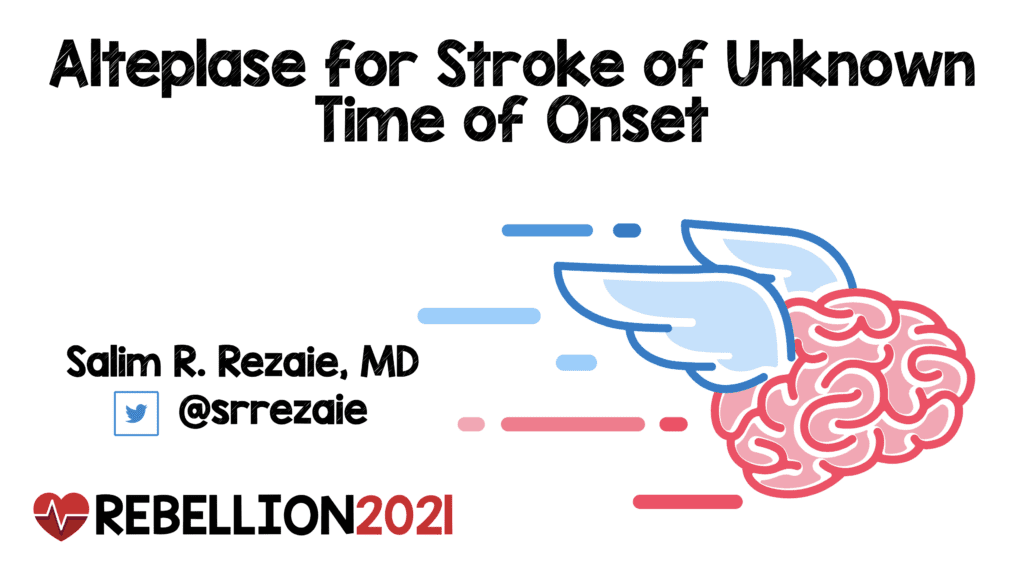
 In this 9 minute video from day 2 of Rebellion in EM 2021, I go over the evidence for advanced imaging use in acute ischemic stroke of unknown time of onset to help guide treatment with intravenous alteplase.
In this 9 minute video from day 2 of Rebellion in EM 2021, I go over the evidence for advanced imaging use in acute ischemic stroke of unknown time of onset to help guide treatment with intravenous alteplase.
What They Did:
- Systematic review and meta-analysis of individual patient data of trials
- RCTs of IV tPA vs standard care or placebo in adults with stroke of unknown time of onset + perfusion-diffusion MRI, perfusion CT, or MRI with diffusion weighted imaging-fluid attenuated inversion recovery (DWI-MRI)
Primary Outcome: Favorable functional outcome (Score of 0 to 1 on the mRS) at 90d
Results:
- 4 trials met eligibility criteria (843 patients could have meta-analysis performed)
-
WAKE-UP 503 patients using 0.9mg/kg alteplase
- Terminated early due to cessation of funding
-
EXTEND 225 patients using 0.9mg/kg alteplase
- Terminated early due to results of WAKE-UP
- THAWS 131 patients using 0.6mg/kg alteplase
- Terminated early due to results of WAKE-UP
- ECASS-4 119 patients using 0.9mg/kg alteplase
- Terminated early due to lack of recruitment
- All 4 trials stopped early
-
WAKE-UP 503 patients using 0.9mg/kg alteplase
-
Favorable Functional Outcome (mRS 0 to 1) at 90d (Primary Outcome):
- Alteplase: 47%
- Control: 39%
- aOR 1.49; 95% CI 1.10 to 2.03; p = 0.011
- NNT = 12
- Death at 90d:
- Alteplase: 6%
- Control: 3%
- aOR 2.06; 95% CI 1.03 to 4.09; p = 0.40
- Symptomatic ICH:
- Alteplase: 3%
- Control: <1%
- aOR 5.58; 1.22 to 25.50; p = 0.024
Limitations:
- All 4 trials stopped early and only had modest sample sizes which limits the strength/precision of the findings and can overestimate benefit of the individual trials
- Only one study used 0.6mg/kg of intravenous alteplase and therefore no definitive conclusions can be made about lower dosing vs higher dosing from this meta-analysis
- The requirement of advanced imaging beyond non-contrast CT and vessel imaging might still be a potential limitation for implementation in some regions
Discussion:
- The availability of perfusion imaging can affect all stroke care, where time is no longer brain. There will be plenty of patients who present <3 hours with no penumbra and no mismatch. This group may not require thrombolysis and perfusion imaging can help confirm that and spare them the potential harms
- One thing to consider in this study is that despite having a lower number of deaths in the control group (mRS 6) compared to alteplase there were far more patients who were bedridden (mRS 5). This is a tough one to wrestle with from a patient care standpoint. Do we save a life at the expense of being bedridden or do we spare the patient being bedridden at the expense of death?
Bottom Line: This meta-analysis provides level 1a evidence for the use of advanced brain imaging beyond non-contrast CT to help guide treatment with intravenous alteplase in patients with acute ischemic stroke with an unknown time of onset. However, despite a consistently better functional outcome at 90d with alteplase compared to placebo or standard of care there was still an increased risk of symptomatic intracranial hemorrhage and a higher mortality which has also been consistent across all randomized clinical trials.
Reference:
- Thomalla G et al. Intravenous Alteplase for Stroke with Unknown Time of Onset Guided by Advanced Imaging: Systematic Review and Meta-Analysis of Individual Patient Data. Lancet 2020. PMID: 33176180
Post Peer Reviewed By: Anand Swaminathan, MD (Twitter: @EMSwami)
The post Rebellion21: Alteplase for Stroke of Unknown Time of Onset appeared first on REBEL EM - Emergency Medicine Blog.
